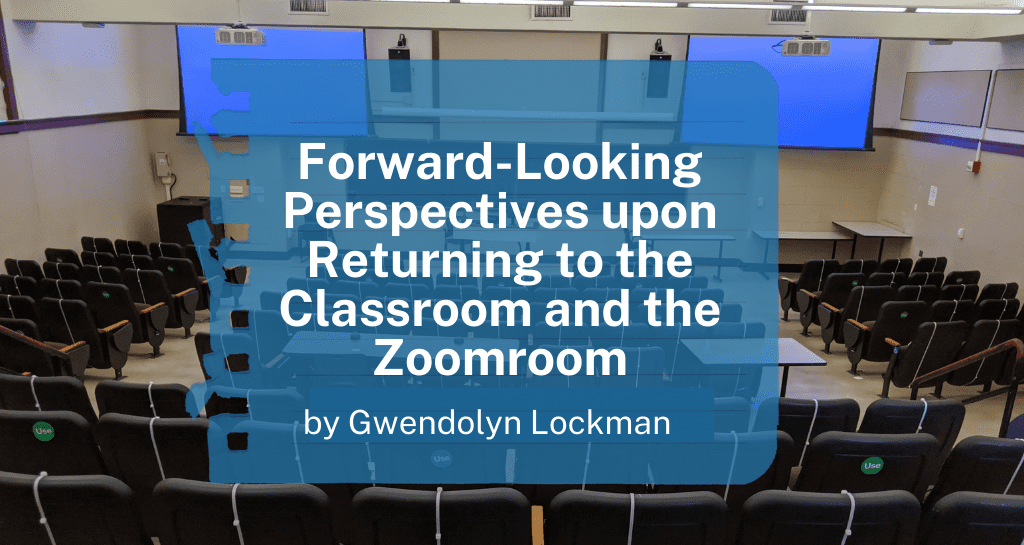
We hoped we would face a more “normal” fall for 2021. Instead, we face another semester that will demand flexibility in the face of anxiety as we continue to teach through the Coronavirus pandemic and the Delta variant surge. After scrambling to adapt to online learning environments in March 2020, many of us are returning to in-person classrooms as well as modified learning environments for the Fall 2021 semester. Online teaching and learning revealed many valuable intangibles from the physical classroom. However, we also have an invaluable opportunity to discard old habits that hindered both faculty and teaching assistants, and exhausted students. What follows is a handful of suggestions about what to enthusiastically reinstate in the classroom, what to leave in 2020 without looking back, and what to adopt from online learning for face-to-face instruction.
Bring it Back
One of the greatest losses of online instruction was the ability of instructors, assistants, and students to get to know one another. Communication became hugely limited. We lost the passing conversations at the start and end of class, the recognition of sharing multiple courses with another student, the buzz of laughter (or not) at a lecturer’s joke. There is value in seeing one another and knowing one another.

The first thing to bring back to the classroom is learning and using students’ names. For many online classes, especially those delivered in webinar format or offered asynchronously, this might have been impossible for faculty, and difficult for teaching assistants. Learning all student names in a large lecture course may be difficult for instructors. But using names can be just as important and beneficial to helping students feel more valued and more invested in courses, according to CBE Life Sciences Education.[1] Name placards in large lecture halls and recognition of student names can help everyone feel more comfortable asking for help, talking to the instructor outside of class, and being confident in their mastery of course material. If this is not feasible in a large lecture course, teaching assistants can learn the names of students in their assigned sections to help achieve similar results. Group projects can help students learn each other’s names too.
In smaller classrooms, engaging in small talk, questions about campus and current events, and playing ice breaker games within the first two weeks of class can help students and instructors get to know one another. UT History Professor Dr. Ashley Farmer offers a model for engaging student-led discourse for the first five minutes of class, which is adaptable to large lecture halls and seminars.[2] She notes that these conversations help students invest in the course, build connections between course materials and the world around them, understand and learn from each other, and understand course content in broad contexts that lecturing might not allow or facilitate.
Learning student names and establishing patterns of student contribution to the class are also important tools in expectation setting. This sometimes-slow work was easy to discount during online learning, especially where the whims of class chat functions might have more influence in determining course culture than a professor’s lecture style. As we return to the classroom, there are positive ways to regain the control we might have felt we lost during online instruction. This is in part an important step for leveling the playing field of navigating higher education, especially as we offer instruction to second-year college students who have yet to be physically present in a university classroom or lecture hall, or third-year students who only have one semester of in-person college in their toolbelts. Go back to basics. Let students know how office hours work, when you check emails, how to read a syllabus, and how to ask for help.
Leave it Behind
There are some pre-pandemic expectations–as well as bad habits we settled into during the pandemic–we should consider leaving behind. First, and above all, drop the distrust of students. There are certain basic standards to uphold, particularly as they pertain to university honor codes. Plagiarism is not okay. But building in more trusting practices for asking for help, extensions, and rescheduled exams can help prevent the issue in the first place. This is easy enough to do through clear expectation setting. Many students don’t know that extensions are an option, and plagiarism becomes a convenient solution when one has run out of options. Consider offering a one-time per semester no questions asked, one-week extension for assignments. This may not work for final exams, when grade deadlines loom, but is a simple solution to integrate into the course.
This also brings us to the use of doctor’s notes and proof of bereavement. The thinking behind offering a no questions asked extension is that sometimes we don’t owe each other explanations, or that we do not have one. Academics miss deadlines frequently, as do employees in office settings.

While missing a deadline might have varying consequences in the workplace, we should trust students are not immune from “real life” and need to treat them as adults negotiating their personal and professional boundaries in the transition from secondary school student to college graduate. Put simply, students don’t owe you their trauma, nor do you owe them yours. What do you stand to gain by requiring students to explain precisely how they are struggling outside of the classroom? While we might want to understand where students are coming from, or to ensure they are not misleading us, I am convinced after receiving dozens of emails from students caring for younger siblings, taking on jobs to help families with sick or recently deceased parents, and trying to turn in assignments while attending funerals, that we don’t need to put students through this. I also went through my own health crisis during the pandemic. Looking back on the emails I sent my professor from the emergency room to explain that I couldn’t make class today but might try in two days, I realize it all could and should have waited.
This brings us back to classroom expectation setting, and drawing your own boundaries is just as important for setting expectations for yourself as for the students in your courses. Modeling positive behavior is a cornerstone of learning and adaptation, whether it is in the primary school classroom, the higher education lecture hall, or the workplace. Consider rethinking email policies to be explicit with students about when you will and will not answer emails. Follow that up by refraining from replying in the wee hours of the morning, or at least using the “schedule send” function common in web-based inboxes these days. Frankly, it is awkward to receive emails in the middle of the night, unless there is a significant time difference between correspondents. Work-from-home presents the danger of further entrenching the idea that we are always available for work. We do not have to accept or promote this model. Email policies are simple means of boundary-setting that can avoid any unintended connotations, expectations, or stresses caused by erratic communication schedules.
My email policy is that I do not respond to messages between 10 pm and 6 am, ever. I don’t check email then if I can help it, and if I do, I schedule send for the morning. I encourage students to ask for help as soon as they think they need it but to expect I will get to their email early in the morning if they send something urgent in the night hours. I am modeling boundary setting, a schedule that includes off-hours, and clear communication. We can also block off weekends or days when we have other engagements. This is another case where we might consider what explanations we owe students. It might open students’ eyes to the world of faculty by telling them about a conference or other professional development activities, but it might not be necessary to share your traumas with students. Boundaries exist for both parties–educators and students.
The Changing Role of Tech
I was a student who sat at the front of a classroom with a notebook and pen. Personally, I am not a fan of laptop use in lecture-based classes, but it is discriminatory to prohibit the use of technology in class, and it is a dated perspective we should not maintain after the pandemic made online learners out of many of us.[3] Without a doubt, there is research to back up the claim that taking notes by hand is better than typing notes for learning and thinking. In certain studies, laptop users did not perform as well on exams as students who took notes by hand.[4] But we are training students in more than notetaking and exam taking (more on that later). Moreover, there are also studies which suggest that students who use laptops in class have better computer skills, spatial awareness, participation, interest in learning, and motivation to do well.[5] There are two big takeaways here: we should trust students to figure out what works best for them, and we should reconsider what we’re really asking of and facilitating for students. What skills do students need to get out of courses? What opportunities are we missing out on by resisting technology?
This question seeps in to how we evaluate students, too. What are we getting out of in-class exams in blue books? I am not calling for prohibition of in-class exams. It feels easier to curtail plagiarism, there are established means of offering accommodations, and it is easy to be abundantly clear about scheduling. But what opportunities are we missing out on by requiring several in-class exams per semester as the only means of evaluating students? What skills are we providing students for life after college? Maybe we can restructure our classes to offer several types of evaluations and several opportunities for different kinds of success. Being a good test taker isn’t much of a skill in the workplace, but working collaboratively on group projects, reading and comprehending reports quickly, and writing succinct memos, pitches, and communications are.

We might remind ourselves of the true purpose of evaluation, namely gauging what students are learning, how effective we are in communicating to students, and whether our framing of information is helpful. Furthermore, trying out different kinds of evaluation can better help students figure out where they excel in different fields, rather than dooming them to dismiss courses based on what they feel they fail at. As a historian, I’m not always as adept as my peers are at understanding theory or using academic terms like “ontological” or “heuristic.” But I excel at presentations and interpersonal communication. These skills are still valuable to historians, along with several other professions and fields. If we don’t give students opportunities to enjoy our courses, they won’t. We offer students more chances to enjoy material outside their comfort zone if they have options for how to approach learning.
One more point on technology and trust: if you are still teaching online this semester, stop with the surveillance of students’ study spaces and automated means of proving they aren’t cheating.[6] TurnItIn is an appropriate and useful way to check for written plagiarism, but the programs that track students’ eye movements and clicks, or instructors who require students show videos of their rooms, are out of line. This Orwellian, if not Machiavellian, model of instruction does little to promote or center student learning. It creates working environments and relationships built on distrust. There are many valuable tools for integrating tech into the classroom that we need to carry forward into face-to-face instruction. Surveillance is not one of them.
Carry it Forward
Online learning presented us with plenty of challenges, but it also forced many of us into an innovative teaching mode we might not have chosen otherwise. There are dozens of online tools for learning that can help us teach at the university level, and that students have already used in their secondary school classrooms for years. We can integrate web-based quiz, poll, and forum platforms, dynamic online group projects, and plagiarism-checking services into our classrooms. Much of this tech is not new and is well-developed at this point. Instead of eschewing the presence of laptops and cellphones in classes, we can ask that students use those devices to engage with courses. If you aren’t sure where to start, ask your students what platforms they like using. They undoubtedly have opinions and experience.
Online learning facilitated conversations–though certainly not all topics or strategies–about accessibility and learning. We need to continue thinking about and acting on how to make classrooms accessible.[7] Maybe it means rethinking your technology policies, seating charts, attendance and tardy policies, or assignment design. One way to demystify asking for help is bringing resource-providers to the classroom. Build in time–whether 5 or 50 minutes–for representatives from campus libraries, writing centers, student success centers, tutors, disability services and accommodations, and mental health and counseling services to come to class. It might not be possible for you to help every single student in class, and you might not be the right person to help in a given situation, but the least we can do is help students gain access to resources that already exist.

Above all, we should carry with us the adaptability to rapidly changing circumstances, the valuing of human interaction, and the openness to connecting the classroom to the world around us. Many of us missed in person teaching, campus events, and a sense of community. We were challenged to adapt syllabi that had not changed much in several years. Some of us were confronted with how public health fit in to fields where we had never previously considered it. The Covid-19 pandemic has been exhausting, and we should recognize that with grace for ourselves, our colleagues, and the students we teach. We will undoubtedly face more challenges in the coming academic year and the ongoing health crisis. To end on a more hopeful note, though, may we be invigorated by the possibilities that come from reentering spaces for learning and soon reach a day where we can leave our haphazard home recording studios behind.
Gwen Lockman is a PhD student in U.S. History at the University of Texas at Austin. She is a historian of U.S. labor and leisure, with interests in work, play, class, community, identity, race, gender, and culture in the 19th and 20th centuries, particularly in the American West. Her current research uses park spaces in Butte, Montana, including the Columbia Gardens amusement park (1876-1973) and plans for new parks to come from Superfund cleanup, to investigate the socio-environmental history of mining, land use, and culture from the 1870s to the present.
[1] Katelyn M. Cooper, Brian Haney, Anna Krieg, and Sarah E. Brownell, “What’s in a Name? The Importance of Students Perceiving That an Instructor Knows Their Names in a High-Enrollment Biology Classroom,” CBE Life Sciences Education, Vol. 16, No. 1 (Spring 2017), https://www.ncbi.nlm.nih.gov/pmc/articles/PMC5332051/.
[2] Not Even Past, “A Conversation about Teaching with Dr. Ashley Farmer,” September 3, 2020, https://notevenpast.org/a-conversation-about-teaching-with-dr-ashley-farmer/.
[3] Katie Rose Guest Pryal, Jordynn Jack, “When You Talk About Banning Laptops, You Throw Disabled Students Under the Bus,” November 27, 2017, https://www.huffpost.com/entry/when-you-talk-about-banning-laptops-you-throw-disabled_b_5a1ccb4ee4b07bcab2c6997d.
[4] James Doubek, “Attention Students: Put Your Laptops Away,” NPR Weekend Edition Sunday, April 17, 2016, https://www.npr.org/2016/04/17/474525392/attention-students-put-your-laptops-away; Nancy M. Aguilar-Roca, Adrienne E. Williamss, Diane K. O’Dowd, “The impact of laptop-free zones on student performance and attitudes in large lectures,” Computers & Education, Vol. 59, No. 4 (December 2012): 1300-1308, https://doi.org/10.1016/j.compedu.2012.05.002.
[5] Michael Trimmel, Julia Bachmann, “Cognitive, social, motivational and health aspects of students in laptop classrooms,” Journal of Computer Assisted Learning, Vol. 20, No. 2 (April 2004), https://doi.org/10.1111/j.1365-2729.2004.00076.x.
[6] Drew Harwell, “Cheating-detection companies made millions during the pandemic. Now students are fighting back,” the Washington Post, November 12, 2020, https://www.washingtonpost.com/technology/2020/11/12/test-monitoring-student-revolt/.
[7] Charlotte McClain-Nhlapo, “An Inclusive Response to Covid-19: Education for Children with Disabilities,” Global Partnership for Education, May 11, 2020, https://www.globalpartnership.org/blog/inclusive-response-covid-19-education-children-disabilities.
The views and opinions expressed in this article or video are those of the individual author(s) or presenter(s) and do not necessarily reflect the policy or views of the editors at Not Even Past, the UT Department of History, the University of Texas at Austin, or the UT System Board of Regents. Not Even Past is an online public history magazine rather than a peer-reviewed academic journal. While we make efforts to ensure that factual information in articles was obtained from reliable sources, Not Even Past is not responsible for any errors or omissions.



